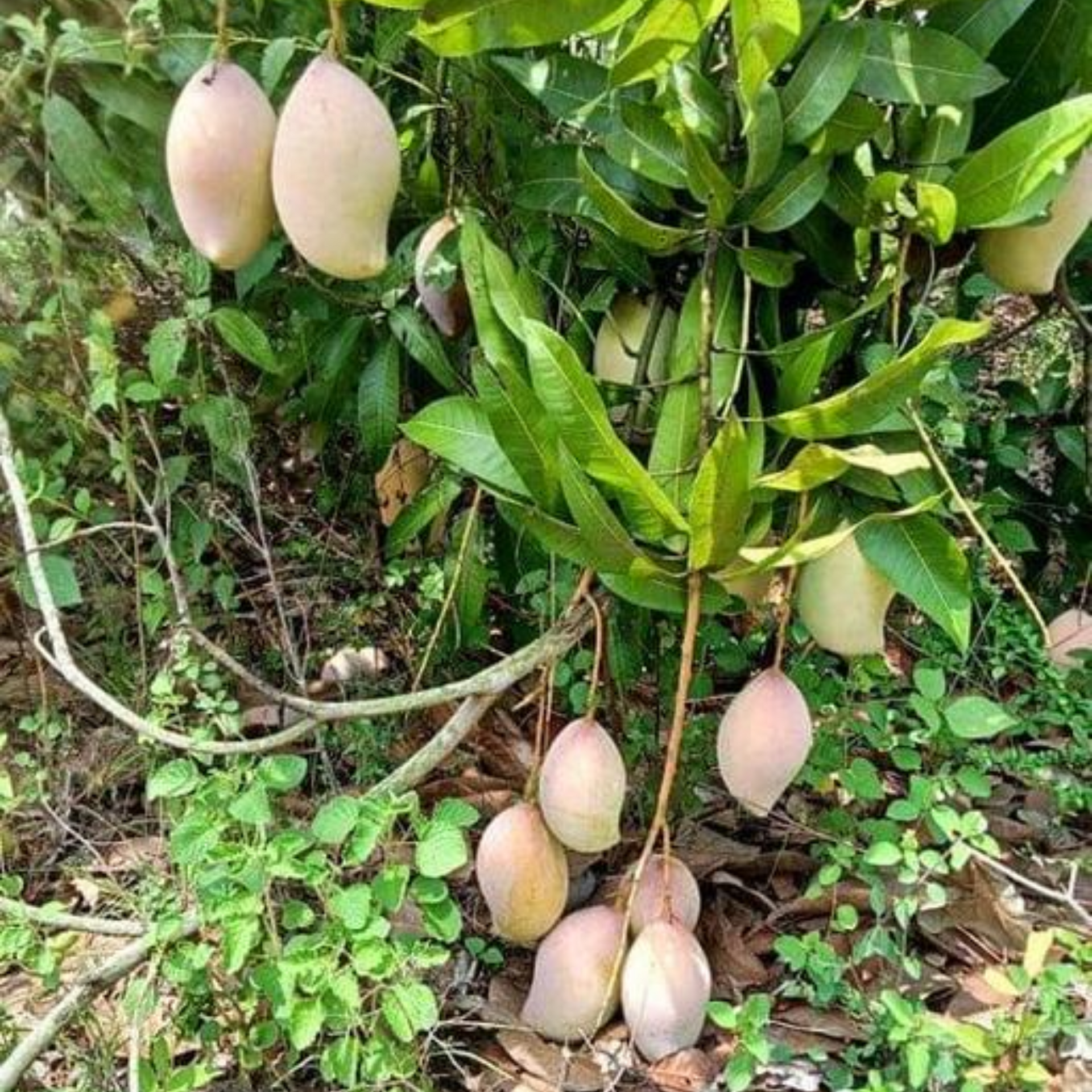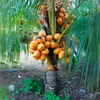


Green Paradise Offers
Exclusive Totapuri Mango Plant
About Totapuri Mango Plant
Totapuri mango (Mangifera indica 'Totapuri') is a popular mango variety cultivated primarily in the southern parts of India, especially in the state of Andhra Pradesh. It is known for its distinctive shape, which resembles a parrot's beak, giving it the nickname "Totapuri" or "Totapari," which means "parrot" in Telugu.
Here are some key characteristics of the Totapuri mango plant:
Tree:
The Totapuri mango tree is a medium to large-sized evergreen tree with a dense canopy. It can reach a height of 30 to 40 feet (9 to 12 meters) when fully mature.
Leaves:
The leaves of the Totapuri mango tree are dark green, glossy, and elliptical in shape. On the branches, they are positioned alternately.
Flowers:
The mango tree produces small, fragrant, white, or cream-colored flowers in panicles. These flowers are bisexual, containing both male and female reproductive parts.
Fruits:
Totapuri mangoes are large-sized fruits, usually measuring 8 to 10 inches (20 to 25 centimeters) in length. They have an elongated shape with a curved tip, resembling a parrot's beak. The skin of the mango is bright yellow when ripe and has a smooth texture with a thin wax coating. The flesh is firm and fiberless, with a pale yellow color. The flavor of the Totapuri mango is tangy and slightly acidic, making it suitable for various culinary uses.
Harvesting:
Totapuri mangoes typically mature and ripen during the summer months, usually between April and June. They are harvested when the fruits have reached the desired size, color, and firmness.
Culinary Uses:
Totapuri mangoes are widely used in the culinary world, both in ripe and unripe forms. Ripe Totapuri mangoes are consumed fresh or used in salads, desserts, smoothies, and fruit juices. They are also processed into mango pulp, which is used in the production of jams, jellies, ice creams, and other mango-based products. Unripe Totapuri mangoes, with their tangy taste, are often used for pickling, chutneys, and other savory dishes.
Nutritional Value:
Totapuri mangoes are a good source of essential nutrients, including vitamins A, C, and E. They also provide dietary fiber and minerals such as potassium and magnesium. However, the nutritional content can vary depending on the ripeness of the fruit.
Totapuri mangoes are highly regarded for their unique shape, distinct flavor, and culinary versatility. They are exported to various countries and are widely enjoyed both within India and internationally.
How To Grow Totapuri Mango Plant
To grow a Totapuri mango plant, you can follow these general steps:
Obtain a Totapuri mango seed:
Obtain a ripe Totapuri mango and extract the seed from the fruit. Clean the seed and remove any remaining fruit pulp.
Prepare the seed:
Soak the mango seed in water for about 24 hours to soften the outer shell. This will help with germination.
Germination:
After soaking, plant the mango seed horizontally in a pot or container filled with well-draining soil. Make sure the soil is wettish but not doused Bury the seed about 1-2 inches deep.
Provide suitable growing conditions:
Place the pot in a warm and sunny location where the plant can receive plenty of sunlight. The ideal temperature range for mango seed germination is around 75-85°F (24-29°C).
Watering and care:
Keep the soil consistently moist but avoid overwatering, as it can lead to rot. Water the seedling regularly, but allow the top inch of soil to dry out before watering again. Ensure good drainage to prevent waterlogging.
Transplanting:
Once the seedling grows into a small sapling with multiple leaves and a strong root system, it's ready to be transplanted into a larger pot or directly into the ground. Ensure the new container or location provides enough space for the mango tree to grow.
Pruning and shaping:
As the mango tree grows, you may need to prune and shape it to maintain a desired form and promote healthy growth. Prune any dead or diseased branches and trim the tree to encourage a strong structure.
Fertilization:
Fertilize the Totapuri mango tree regularly with a balanced fertilizer, preferably one formulated specifically for fruit trees. Follow the instructions on the toxin packaging for operation rates and frequence.
Pest and disease management:
Monitor your mango tree for pests and diseases regularly. Common pests include aphids, scale insects, and fruit canvases. If you notice any signs of infestation or disease, take appropriate measures to control them, such as using organic insecticides or seeking advice from a local gardening expert.
Patience and care:
Growing a mango tree from seed can take several years before it starts bearing fruit. Be patient and continue to provide proper care, including regular watering, fertilization, and maintenance, until your Totapuri mango tree matures and starts producing delicious mangoes.
Remember that specific regional or climatic conditions may require slight adjustments to these instructions. It's always helpful to consult with local gardening experts or agricultural extension services for guidance specific to your area.
𝗥𝗲𝗹𝗮𝘁𝗲𝗱 𝗽𝗿𝗼𝗱𝘂𝗰𝘁𝘀
Flowering Plants
Green Paradise® Pink Lotus Tuber for Pond & Water Gardens – Healthy, Ready to Grow Aquatic Flower Plant Bulb
Green Paradise® Pink Lotus Tuber – Premium Aquatic Flower Plant ✨ Product Description: Bring the beauty of vibrant pink lotus blooms to your water garden or pond with the Green...
Rs. 549.00
Flowering Plants
Rare Heliconia Wagneriana Live Plant Heliconia psittacorum Live Plant
Introducing the Exquisite Heliconia Psittacorum Plant: A Tropical Marvel for Your Home Elevate your indoor and outdoor spaces with the captivating beauty of the Heliconia Psittacorum Plant. Renowned for its...
Rs. 499.00
Flowering Plants
Green Paradise Live-Heliconia Wagneriana Plant with Plastic Pot
Green Paradise Offer Beautiful Heliconia Wagneriana Plant About Heliconia Wagneriana Plant Heliconia wagneriana is a stunning and attractive tropical plant known for its unique and colorful inflorescence. Here's what I can...
Rs. 499.00
Flowering Plants
Heliconia rostrata Live Plant heliconia plant Heliconia psittacorum Live Plant
Introducing the Heliconia psittacorum Plant – Nature's Exotic Masterpiece! About Heliconia Psittacorum Plant: Elevate your garden to new heights with the breathtaking Heliconia psittacorum Plant, a true marvel of nature....
Rs. 499.00
Outdoor Plant
Green Paradise® Water Rose (Pistia) – Live Water Cabbage Aquatic Plant for Ponds, Aquariums & Water Gardens | Natural Oxygenating Floating Plant
Green Paradise® Water Rose (Aquatic Pistia) Plant Welcome to the lush world of Green Paradise® Water Rose (Aquatic Pistia)! Our aquatic plant is more than just a decorative addition to your...
Rs. 399.00
Seeds
Heliconia Golden Torch plant bulbs positive energy and beautiful flowers giving Plant species. (pack of 3)
Green Paradise offers Heliconia Golden Torch Plant About Heliconia Golden Torch Plant Heliconia Golden Torch is a beautiful and striking tropical plant known for its bright and vibrant inflorescence....
Rs. 399.00
Seeds
Heliconia Plant Bulbs Heliconia bihai x marginata 'Rauliniana' 5 Bulbs-Green Paradise Live
Green Paradise Offers Heliconia bihai x Marginata Rhizomes (Pack of 5 Bulbs) About Heliconia Marginata Heliconia marginata, also known as the Red Bassy or Lobster Claw, is a stunning tropical plant...
Rs. 749.00
Flowering Plants
Heliconia bird of paradise Live healthy Plant-Green Paradise Live
Green Paradise Offers Beautiful Heliconia Bird Of Paradise Plant About Heliconia Bird Of Paradise Plant It seems like there might be a slight confusion in your question. Heliconia and Bird of...
Rs. 349.00






